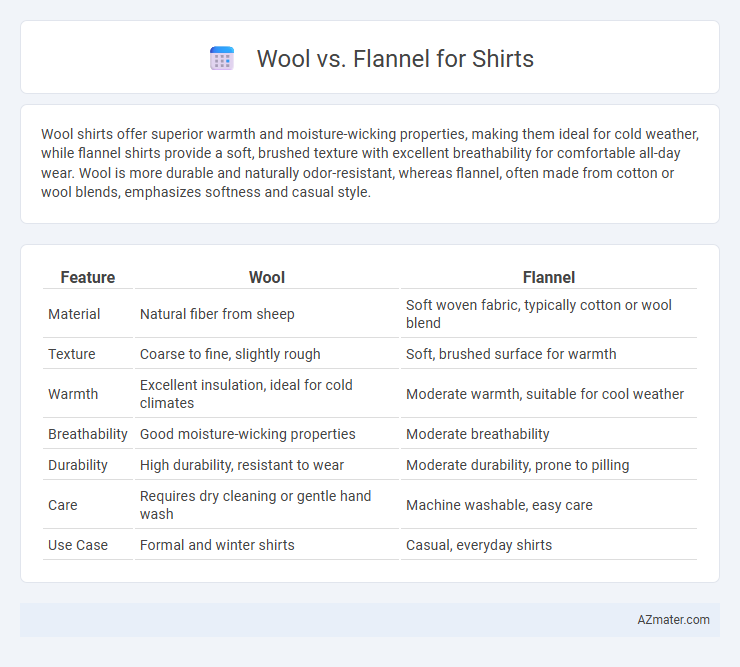Wool shirts offer superior warmth and moisture-wicking properties, making them ideal for cold weather, while flannel shirts provide a soft, brushed texture with excellent breathability for comfortable all-day wear. Wool is more durable and naturally odor-resistant, whereas flannel, often made from cotton or wool blends, emphasizes softness and casual style.
Table of Comparison
| Feature | Wool | Flannel |
|---|---|---|
| Material | Natural fiber from sheep | Soft woven fabric, typically cotton or wool blend |
| Texture | Coarse to fine, slightly rough | Soft, brushed surface for warmth |
| Warmth | Excellent insulation, ideal for cold climates | Moderate warmth, suitable for cool weather |
| Breathability | Good moisture-wicking properties | Moderate breathability |
| Durability | High durability, resistant to wear | Moderate durability, prone to pilling |
| Care | Requires dry cleaning or gentle hand wash | Machine washable, easy care |
| Use Case | Formal and winter shirts | Casual, everyday shirts |
Wool vs Flannel: Key Differences Explained
Wool shirts are made from natural animal fibers, offering superior warmth, moisture-wicking, and durability, making them ideal for cold weather and outdoor activities. Flannel, typically made from cotton or wool, is a soft, brushed fabric known for its cozy feel and lightweight comfort, perfect for casual wear and layering. While wool excels in insulation and moisture control, flannel provides a smooth texture and breathability, influencing choice based on climate and activity needs.
Fabric Origins: Wool and Flannel Histories
Wool originates from the fleece of sheep, with its use dating back thousands of years to ancient civilizations including Mesopotamia and Egypt, prized for warmth and durability. Flannel began in 17th-century Wales as a soft, napped fabric traditionally made from carded wool, evolving into blends of cotton or synthetic fibers for enhanced comfort and versatility. Both textiles reflect rich histories tied to cold climates and practical garment needs, embedding heritage in their production and cultural significance.
Texture and Feel: Comfort Comparison
Wool shirts offer a naturally insulating texture with a slightly coarse yet soft feel that provides warmth and breathability, ideal for cooler climates. Flannel shirts are characterized by their brushed, fuzzy surface that delivers a plush, smooth touch, enhancing comfort and softness against the skin. The tactile difference shows wool as more structured and durable, while flannel emphasizes cozy, lightweight comfort suitable for layering.
Warmth and Insulation: Which is Better?
Wool offers superior warmth and natural insulation due to its ability to retain heat even when damp, making it ideal for cold and wet conditions. Flannel, typically made from cotton or wool, provides a soft and cozy feel but lacks the advanced thermal properties of pure wool fabrics. For optimal insulation and cold-weather performance in shirts, wool is generally the better choice.
Durability and Longevity: Wool vs Flannel Shirts
Wool shirts offer superior durability due to their natural resilience and resistance to wear, maintaining their shape and texture over time. Flannel shirts, while soft and comfortable, tend to pill and thin with frequent washing, reducing their lifespan compared to wool. Investing in high-quality wool ensures longer-lasting garments that withstand daily use without significant deterioration.
Moisture Management and Breathability
Wool excels in moisture management by naturally wicking sweat away from the skin and drying quickly, making it ideal for temperature regulation in various conditions. Flannel, typically made from cotton or wool blends, offers moderate breathability but retains more moisture, which can lead to a damp and uncomfortable feel during extended wear. For superior breathability and effective moisture control in shirts, wool is preferred over flannel, especially in active or variable climates.
Style and Versatility: Fashion Considerations
Wool shirts offer a classic, textured look with excellent insulation, making them ideal for colder seasons and formal or rugged styles, while flannel shirts provide a soft, cozy feel with a casual, laid-back appearance suited for everyday wear and layering. Wool's natural sheen and durability lend themselves to versatile outfits that can transition from outdoor activities to urban settings, whereas flannel's vibrant patterns and breathable fabric enhance comfort and easy pairing with jeans or chinos. Choosing between wool and flannel depends on desired style outcomes and versatility needs, balancing warmth, texture, and fashion preferences.
Maintenance and Care Requirements
Wool shirts require gentle washing with cold water and mild detergent to prevent shrinking and maintain fabric integrity, often needing air drying to avoid damage. Flannel shirts, typically made from cotton or a cotton blend, are machine washable but benefit from cold or warm water cycles and low heat drying to minimize pilling and preserve softness. Proper storage, avoiding excessive heat or moisture, extends the lifespan of both wool and flannel shirts while maintaining their texture and fit.
Environmental Impact: Sustainability Factors
Wool shirts offer excellent sustainability due to their natural biodegradability, renewable source, and lower carbon footprint compared to synthetic fabrics. Flannel, often made from cotton or blends, raises concerns over intensive water use, pesticide application, and higher energy consumption during production. Choosing responsibly sourced wool or organic cotton flannel can significantly reduce environmental impact by promoting sustainable farming and reduced chemical dependency.
Choosing Between Wool and Flannel: Final Recommendations
Wool shirts offer superior warmth, moisture-wicking properties, and natural breathability, making them ideal for cold, damp conditions and extended outdoor wear. Flannel shirts provide a softer feel and a cozy texture with excellent insulation, perfect for casual, everyday use in moderately cool weather. Choosing between wool and flannel depends on prioritizing durability and temperature regulation versus softness and style versatility.

Infographic: Wool vs Flannel for Shirt
 azmater.com
azmater.com